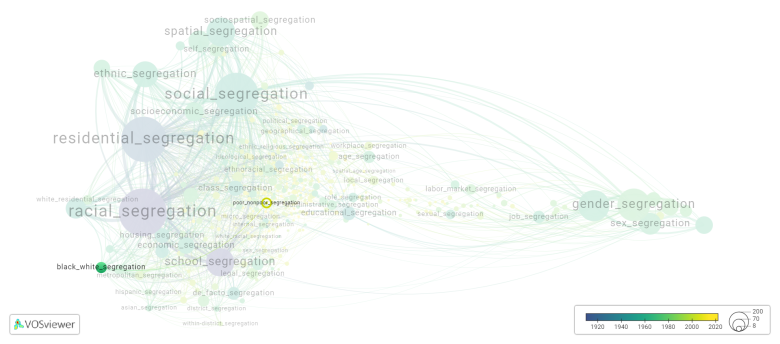Poor nonpoor segregation: Difference between revisions
(Creating page) |
(Creating page) |
||
| (One intermediate revision by the same user not shown) | |||
| Line 20: | Line 20: | ||
[[File:poor_nonpoor_segregation.png|780x780px]] | [[File:poor_nonpoor_segregation.png|780x780px]] | ||
This visualization is based on the study [[Segregation_Wiki:About| The Multidisciplinary Landscape of Segregation Research]]. | |||
For the complete network of | For the complete network of interrelated segregation forms, please refer to: | ||
* | * [https://tinyurl.com/2235lkhw First year of publication] | ||
* | * [https://tinyurl.com/2d8wg5n3 Louvain clusters] | ||
* | * [https://tinyurl.com/223udk5r Betweenness centrality] | ||
* | * [https://tinyurl.com/244d8unz Disciplines in which segregation forms first emerged (Scopus database).] | ||
==References== | ==References== | ||
==Notes== | ==Notes== | ||
Latest revision as of 07:17, 16 October 2024
Date and country of first publication[1][edit | edit source]
2014
United States
Definition[edit | edit source]
Poor nonpoor segregation refers to the separation of individuals based on their socioeconomic status, specifically distinguishing between those who are poor and those who are non-poor or wealthier. This type of segregation can manifest in various aspects of society, including neighborhoods, schools, and even access to certain services and opportunities.
In terms of housing, poor nonpoor segregation occurs when low-income individuals are concentrated in impoverished neighborhoods, while wealthier individuals reside in more affluent areas. This division can result from various factors, such as limited affordable housing options, discriminatory practices, and the perpetuation of socioeconomic inequalities.
Schools are also affected by poor nonpoor segregation, as lower-income students tend to attend underfunded schools in disadvantaged areas, while wealthier students have access to better-funded schools with more resources. This segregation can lead to unequal educational opportunities and perpetuate the cycle of poverty.
Furthermore, poor nonpoor segregation can manifest in the limited access to services and opportunities for low-income individuals. For example, healthcare facilities, recreational spaces, and job opportunities may be concentrated in wealthier areas, creating barriers for poor individuals to access these essential resources.
Overall, poor nonpoor segregation reflects the unequal distribution of wealth and resources in society, perpetuating socioeconomic inequalities and limiting opportunities for low-income individuals to improve their lives. Addressing this issue requires efforts to provide affordable housing, improve education in disadvantaged areas, and provide equal access to services and opportunities for all individuals, regardless of their socioeconomic status.
See also[edit | edit source]
Related segregation forms[edit | edit source]
Poor nonpoor segregation is frequently discussed in the literature with the following segregation forms:
residential segregation, black white segregation

This visualization is based on the study The Multidisciplinary Landscape of Segregation Research.
For the complete network of interrelated segregation forms, please refer to:
References[edit | edit source]
Notes[edit | edit source]
- ↑ Date and country of first publication as informed by the Scopus database (December 2023).
At its current state, this definition has been generated by a Large Language Model (LLM) so far without review by an independent researcher or a member of the curating team of segregation experts that keep the Segregation Wiki online. While we strive for accuracy, we cannot guarantee its reliability, completeness and timeliness. Please use this content with caution and verify information as needed. Also, feel free to improve on the definition as you see fit, including the use of references and other informational resources. We value your input in enhancing the quality and accuracy of the definitions of segregation forms collectively offered in the Segregation Wiki ©.
Poor nonpoor segregation appears in the following literature[edit | edit source]
Quillian L. (2014). Does segregation create winners and losers? Residential segregation and inequality in educational attainment. Social Problems, 61(3), 402-426. University of California Press.https://doi.org/10.1525/sp.2014.12193
